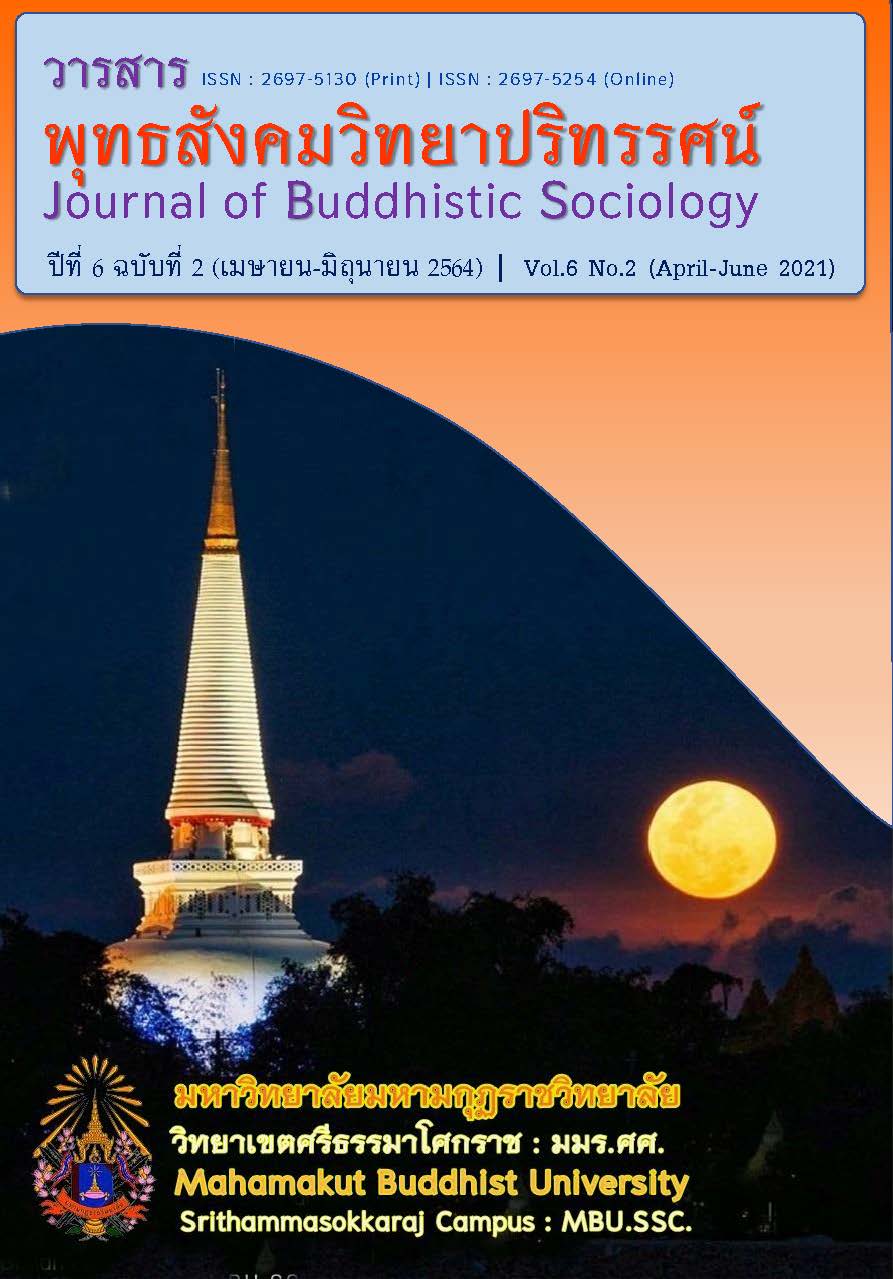MODEL OF INSTRUCTIONAL SUPERVISION BASED ON THE 4 SANGKHAHAVATTHUS OF TEACHERS IN BANWANGPLA SCHOOL UNDER CHOMPHON PRIMARY EDUCATIONAL SERVICE AREA OFFICE 2
Main Article Content
Abstract
The objectives of this research were 1. to study the condition of teaching supervision of Banwangpla School teachers 2. to study the model of teaching supervision in accordance with the 4 Sangkhahavatthus of teachers in Banwangpla School and and 3 to propose the model of teaching supervision in accordance with the 4 Sangkhahavatthus of teachers in Banwangpla School under Chumphon Primary Educational Service Area Office 2. This was qualitative research which collected the data from in-depth interviews. The step of condition study consisted of 10 informants which were a school director, 2 internal supervision committees and 7 teachers who were the learning group leaders. The step of designing the model consisted of 3 people which were a school director, a supervisor and a buddhist scholar. The step of focus group discussion consisted of 7 experts which were a school director, a supervisor, an academician, an internal supervision committee, a committee of the Basic Education Commission and a teacher.
The research showed that:
1. Current conditions of teaching supervision of the teachers at Ban Wang Pla school: the school has run the teaching observation by setting the meeting to create the teachers’ understanding and to clearly set the committees who were responsible for teaching observation. The observation calendar and evaluation form were provided. The teaching observation has been friendly done, one class per one semester. The school encouraged the teachers to have a role as a leader and a follower, and work as a team. The teachers have exchanged some teaching-learning problems, and problems of students’ behavior to plan and solve them together by using PLC (Professional Learning Community). This helped the students have the positive learning attitudes and give the students to continually have higher quality achievement.
2. The teaching supervision in accordance with the 4 Sangkhahavatthus of the teachers in Banwangpla School under Chumphon Primary Educational Service Area Office 2 were as follows: 1) name of a model 2) principles and reason 3) objectives 4) five areas of operational guidelines according to Glickman's supervision which are (a) providing direct assistance to teachers (b) developing group work skills (c) enhancing professional experiences (d) developing curriculum. (E) practicing a classroom action research and 5) monitoring and evaluating.
3. Presentation of the teaching supervision model according to 4 Sangahavatthus of Banwangpla School teachers: it was found that the process and method of teaching supervision were aligned with the objectives of the model created by the researcher through the approval from the experts who agreed that the model was qualified, appropriate, be able to use, useful and practical.
Article Details
References
กระทรวงศึกษาธิการ. (2545). พระราชบัญญัติการศึกษาแห่งชาติ พุทธศักราช 2542 (ฉบับที่ 2) และที่แก้ไขเพิ่มเติม พุทธศักราช 2545. กรุงเทพมหานคร: สยามสปอร์ต ซินดิเค.
______. (2561). คู่มือการปฏิบัติงานของข้าราชการครูและบุคลากรทางการศึกษารักษาการในตำแหน่งผู้อำนวยการสถานศึกษา สังกัดสำนักงานคณะกรรมการการศึกษาขั้นพื้นฐาน. กรุงเทพมหานคร: โรงพิมพ์ชุมนุมสหกรณ์การเกษตรแห่งประเทศไทย.
จันทร์สุดา บุตรชาติ และคณะ. (2556). การพัฒนารูปแบบการประกันคุณภาพภายในสถานศึกษาขั้นพื้นฐาน สังกัดสำนักงานเขตพื้นที่การศึกษาประถมศึกษาสกลนคร เขต 1. วารสารวิชาการมหาวิทยาลัยราชภัฏพระนคร, 4(1), 121.
พระพรหมคุณาภรณ์ (ป. อ. ปยุตฺโต). (2555). พุทธธรรม ฉบับขยาย, ความสุข 2: ฉบับประมวลความ (พิมพ์ครั้งที่ 35). กรุงเทพมหานคร: ผลิธัมม์.
พัชรินทร์ ช่วยศิริ. (2554). การศึกษาการดำเนินงานนิเทศภายในของโรงเรียนวัดประดู่ฉิมพลี. ใน สารนิพนธ์ปริญญาศึกษาศาสตรมหาบัณฑิต สาขาวิชาการบริหารการศึกษา. มหาวิทยาลัยศรีนครินทรวิโรฒ.
พาสนา ชลบุรพันธ์. (2560). รูปแบบการนิเทศการสอนเพื่อส่งเสริมความสามารถในการพัฒนาทักษะการคิดของผู้เรียนระดับการศึกษาขั้นพื้นฐาน. ใน วิทยานิพนธ์ศึกษาศาสตรดุษฎีบัณฑิต สาขาวิชาการจัดการศึกษา. มหาวิทยาลัยธุรกิจบัณฑิตย์.
มาเรียม นิลพันธุ์ และคณะ. (2553). รายงานการวิจัยเรื่องการประเมินโครงการยกระดับคุณภาพครูทั้งระบบ กิจกรรมพัฒนานิเทศแนวใหม่. นครปฐม: มหาวิทยาลัยศิลปากร.
รุ่ง แก้วแดง. (2561). ปฏิวัติการศึกษาไทย (พิมพ์ครั้งที่ 2). กรุงเทพมหานคร: มติชน.
โรงเรียนบ้านวังปลา. (2563). แผนปฏิบัติการประจำปีงบประมาณ 2563.
สำนักงานเขตพื้นที่การศึกษาประถมศึกษาชุมพร เขต 2. (2561). แผนการนิเทศติดตามและประเมินจุดเน้นการนิเทศครั้งที่ 2/2561. ชุมพร: สำนักงานเขตพื้นที่การศึกษาประถมศึกษาชุมพร เขต 2.
สำนักงานคณะกรรมการการประถมศึกษาแห่งชาติ. (2553). แนวทางการประกันคุณภาพการศึกษา. กรุงเทพมหานคร: โรงเรียนคุรุสภาลาดพร้าว.
สำนักงานเลขาธิการสภาการศึกษากระทรวงศึกษาธิการ. (2556). ร่างยุทธศาสตร์การศึกษา พ.ศ. 2556-2558. กรุงเทพมหานคร: พริกหวานกราฟฟิค.
สำเร็จ ยุรชัย และคณะ. (2560). การพัฒนาแนวทางการนิเทศภายในแบบมีส่วนร่วมสำหรับสถานศึกษาขนาดเล็ก สังกัดสำนักงานเขตพื้นที่การศึกษาประถมศึกษาขอนแก่น เขต 1. วารสารวิชาการธรรมทัศน์, 17(3), 39-40.
สุนันทา สบายวรรณ. (2558). การนิเทศภายในของผู้บริหารสถานศึกษาตามความคิดเห็นของครู สังกัดสำนักงานเขตพื้นที่การศึกษาประถมศึกษา จังหวัดปทุมธานี. ใน วิทยานิพนธ์ปริญญาครุศาสตรบัณฑิต สาขาวิชาการบริหารการศึกษา. มหาวิทยาลัยราชภัฏวไลยอลงกรณ์.
อัญชัน ขุนนาแก้ว. (2559). การพัฒนารูปแบบการนิเทศภายในสถานศึกษาเอกชนขนาดใหญ่ประเภทสามัญ เพื่อยกระดับผลลัมฤทธิ์ทางการเรียนของนักเรียนในจังหวัดชลบุรี. ใน ดุษฎีนิพนธ์ปรัชญาดุษฎีบัณฑิต สาขาวิชาการบริหารการศึกษา. มหาวิทยาลัยบูรพา.
เอมอร จันทนนตรี และคณะ. (2560). รูปแบบการนิเทศด้านการวัดและประเมินผลการเรียนรู้ตามหลักพุทธธรรมของสถานศึกษา สังกัดสำนักงานเขตพื้นที่การศึกษามัธยมศึกษา เขต 26. วารสารวิชาการธรรมทัศน์, 17(3), 214-215.
Agih A. Allen. (2015). Effective School Management and Supervision: Imperative for Quality Education Service Deliver. An International Multidisciplinary Jounal, 9(3), 62-74.
Emmanuel O. Adu, et al. (2014). Internal and External School Supervision: Issues, Challenges and Wayforward. International Journal of Educational Sciences, 7(2), 269-278.


